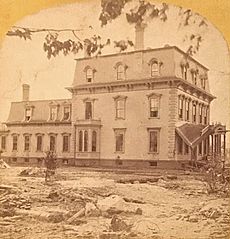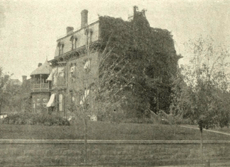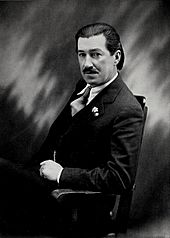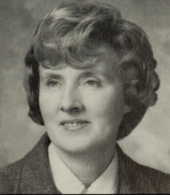Wistariahurst facts for kids
| Former name | Holyoke Museum of Fine Arts and Natural History |
|---|---|
| Established | 1901 (original museum) 1959 (current site) |
| Location | Holyoke, Massachusetts |
| Type | Historic house museum |
| Owner | City of Holyoke |
| Public transit access | Bus: PVTA B23, R24 (all |
|
Wistariahurst
|
|
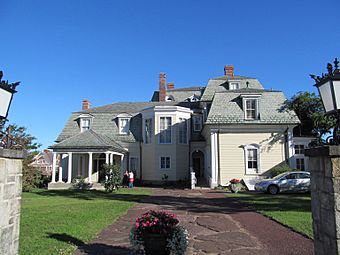
Wistariahurst
|
|
| Lua error in Module:Location_map at line 420: attempt to index field 'wikibase' (a nil value). | |
| Location | 238 Cabot St., Holyoke, Massachusetts |
| Area | 2.5 acres (1.0 ha) |
| Built | 1868 1874 |
| Architect | William Fenno Pratt Clarence Sumner Luce Wilson Eyre |
| Architectural style | Second Empire |
| NRHP reference No. | 73000295 |
| Added to NRHP | April 23, 1973 |
Wistariahurst is a special historic house and museum in Holyoke, Massachusetts. It used to be the home of the Skinner family. The house is located at 238 Cabot Street.
It was built in 1868 for William Skinner. He owned a very successful business that made silk and textiles. The house gets its name from the beautiful wisteria vines. These vines hang down all over its eastern side.
The mansion was first built in Williamsburg in 1868. It was designed by architect William Ferro Pratt. In 1874, a big flood destroyed the Skinner mills. So, the whole mansion was moved to Holyoke!
After Belle Skinner passed away, her music room became a private museum. This was from 1930 to 1959. It held the Belle Skinner Collection of Old Musical Instruments. Later, the family gave these instruments to Yale University.
Since 1959, the house has been known as the Wistariahurst Museum. It is now open for everyone to visit. The property was added to the National Register of Historic Places in 1973. This means it is a very important historic site.
Contents
The Mansion's Design and History
Wistariahurst takes up a whole city block in central Holyoke. It is surrounded by Cabot, Beech, Pine, and Hampshire Streets. A low stone wall with an iron fence goes around the property. There are entrances on Beech Street for cars. The main entrance for walking is on Cabot Street. It has two marble lions guarding it.
The main house is a three-story building made of wood. It has been changed and added to over the years. The oldest part of the house is mostly square. It has a special type of roof called a mansard roof.
The wisteria vines were planted when the house was moved. The name "Wistariahurst" first appeared in a newspaper in 1904. This was for the wedding of Katharine Skinner. A two-story hall was added in 1927. A music room and conservatory were added in 1913.
Inside, the house is beautifully decorated. It has original leather walls in one room. Another room has its original wallpaper. The mansion has 26 rooms and 16 fireplaces.
The oldest part of the mansion was built in Williamsburg. It was moved to Holyoke in 1874. This happened after a big flood destroyed William Skinner's business there. More parts were added to the house in 1913 and 1927.
The Skinner family owned the house and grounds until 1959. Katharine Skinner Kilborne, William Skinner's youngest child, and her family gave Wistariahurst to the City of Holyoke. They wanted it to be used for cultural and educational purposes.
At first, the city thought about tearing it down for a parking lot. But instead, it became the Holyoke Museum of Fine Arts and Natural History. After 1976, it became a cultural and historic house museum.
The Carriage House
The carriage house was designed by William Ferro Pratt. It was built around 1880. It was later made bigger in 1913 to hold cars. After the estate was given to the city, the building became the Holyoke Youth Museum. It had exhibits about Native Americans and animal collections.
The building used to have a large cupola and spire on top. But these were removed by the late 1960s. Some windows were also filled in. By 1980, the entrance was changed to how it looks today.
For a while, the carriage house was not used much. Around 2005, it was decided to fix it up. The plan was to store the museum's collections there. After $1 million in repairs, the building was restored. It reopened in October 2009 as an archive research center.
The Museum's History
Early Beginnings
Before Wistariahurst was donated, the museum was called the Holyoke Museum of Natural History. Later, it became the Holyoke Museum of Fine Arts and Natural History. Its story began with the Holyoke Scientific Club in 1886. This club met to talk about new technologies and science.
In 1887, the club changed its name to the Holyoke Scientific Association. In 1888, it became an official organization. Their goal was to "awaken and maintain an active interest in the Practical Sciences." They also wanted to help with arts, farming, manufacturing, and business.
The museum first opened in the Holyoke Public Library in 1902. It had a collection of Native American stone tools. At first, you could only see the collections by making an appointment.
In 1926, the museum hired Burlingham Schurr as its director. He was a naturalist and taxidermist. He put together a large collection of plants, animals, minerals, and fossils from the area. He worked there until he passed away in 1951.
In 1928, the museum started its art collection by buying 29 paintings. William Skinner II helped with this. In the 1950s, the museum held talks about wildlife and art. These events helped raise money for a permanent home. Many local groups and even Boy Scouts and Girl Scouts helped raise funds.
Finally, in June 1959, the Skinner-Kilborne family gave the Wistariahurst estate to the city. It became the museum's permanent home. Over the years, the museum changed its focus. It started to highlight the Skinner family's silk industry history. By the early 2000s, most of the natural history collections were given to the University of Massachusetts.
The Music Room Era
Belle Skinner passed away in 1928. Her brothers, Joseph and William, wanted to keep her amazing collections safe. This included her famous collection of rare musical instruments. The Skinner family still lived in the house for 30 more years.
In 1930, the Music Room became a museum open to the public. It held the Belle Skinner Collection of Old Instruments. From 1930 to 1933, Nils J. Ericsson took care of the collection. He helped restore many instruments and wrote notes for the collection's catalog.
After Ericsson's death in 1933, Fanny Reed Hammond became the curator. She was a musician and stayed in this role until 1959. During these 30 years, Wistariahurst hosted many clubs and musicians. Serge Koussevitzky, a famous conductor, called the collection "a collection of superlatives."
The collection included a spinet made for Marie Antoinette. There was also a virginal made for Nell Gwyn. Another special piece was a Yuan dynasty era guqin with a famous Chinese poet's signature.
In the mid-1950s, Elizabeth Kilborne Hudnut, a Skinner family heir, wanted more people to see the collection. In 1955, she invited musicians to make the first public recordings of the collection. This resulted in an album called Spotlight on Keyboard. It showed how musical instruments changed over time.
By 1959, the other heirs of the collection no longer wanted to keep it. In May 1959, they talked about donating Wistariahurst to the City of Holyoke. Around the same time, Sibyl Marcuse from Yale University's instrument collection contacted them. She wanted to add to Yale's small collection.
It was decided that two of the nephews, who went to Yale, would donate their part of the collection to the university. Elizabeth's part was bought for $47,000. By the end of July 1959, all the rare instruments were moved to Yale's campus. This made the Yale Collection of Musical Instruments famous worldwide.
The Library Corporation Era
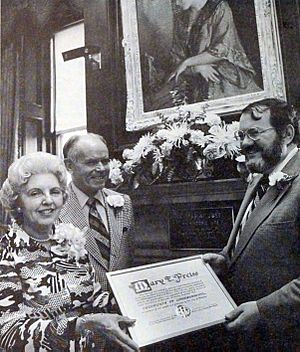
When Wistariahurst first opened to the public in 1959, it was run by the Holyoke Public Library Corporation. This was a private group. The group and its director, Mary Preiss, helped get Wistariahurst listed on the National Register of Historic Places in 1973.
During this time, the museum showed its collections of natural history, art, and artifacts. It also had special exhibits. One famous exhibit in 1968 included a painting by Claude Monet. This painting was borrowed from the Metropolitan Museum of Art.
This period ended in June 1975. The mayor asked the Library Corporation to give control of Wistariahurst to the city. The Library also removed its collections. For a short time, the museum even had a volleyball exhibit.
The museum faced possible closure in 1982. But concerned citizens started a campaign to save it. Luckily, the budget cuts were later stopped.
Visiting Today
Wistariahurst Museum today shows what life was like for two generations of the Skinner family. You can see original leather wall coverings and beautiful woodwork. The museum's collection includes decorative arts, paintings, textiles, and old family papers.
The museum offers many programs and events. These include workshops, concerts, lectures, and demonstrations. You can also rent the museum for private events or group tours. The grounds are often used for weddings and other social gatherings.
The museum hosts yearly events like its Annual Plant Sale. This sale raises money to keep the gardens beautiful. It also has events for students, like "Immigration Experience." This workshop teaches elementary school students about immigrants' lives. They learn about people who came to the United States through Ellis Island. This includes millworkers and even the Skinner family, as William Skinner came from England.
The museum also works with the University of Massachusetts Amherst. They offer workshops for teachers on women's history in the city. They help teachers use old documents in their classrooms.
Working with the Holyoke Public Library, the museum helps save histories of different communities. The Nuestros Senderos project collects stories and photos of Holyoke Puerto Rican history. They also support Black Holyoke, which archives stories of Holyoke's Black community.
Archive Collections
Besides its exhibits and programs, the museum keeps many items in its permanent collections. It started with things donated by the Skinner family. Over the years, the museum has received many donations. These items are related to the culture and industry of Holyoke.
| Ref # | Name | Years | Description |
|---|---|---|---|
| MS 101 | Skinner Family Collection | 1864-1980 | 211 boxes; materials about the Skinner Family and their silk business. |
| MS 201 | Holyoke Collection | 1794–Present | 200 boxes; items about Holyoke's culture, industry, government, and more. |
| 2011.1.2 | Carlos Vega Collection of Latino History in Holyoke | 1948-1980 | 43 boxes; records of Nueva Esperanza and Latino experiences in Holyoke. |
| L2011.028 | Holyoke City Hall Collection | 1859-1976 | 104 volumes; ledger records, including mortgages and legal notices. |
| 2012.019 | Magoon Collection of Papermaking History | 1870-2008 | 8 boxes + equipment; items about paper companies like Am. Writing and Parsons. |
| 2016.010 | Holyoke Canoe Club Collection | 1888-1993 | 15 boxes; rules, money records, postcards, and items about the Holyoke Canoe Club. |
| TEXTILES.001 | Textile Collection | 1830-1970 | 157 boxes; clothing, linens, and accessories. Includes Skinner family clothes. |
| Holyoke Postcard Collection | 1876-1990 | 3 boxes; About 1,900 postcards showing landmarks and nature. | |
| Natural History Collection | 1927-1951 | Burlingham Schurr's animal collections, mostly given to UMass Amherst. The "Frog Circus" is still here. | |
| William Cobbett Skinner Journals | 1876, 1888 | Journals from William Skinner's first son when he was 19 and 31. |
Gallery
-
The eastern side of the house, with its famous wisteria hanging gardens.
-
View of Oyster Bay (1908), by Louis Tiffany. This piece reminds people of the wisteria at the estate. It was made for the Skinner family's New York City home. Today, it is at The Met.
See also
- Belle Skinner
- Joseph Allen Skinner Museum
- William Skinner and Sons
- National Register of Historic Places listings in Hampden County, Massachusetts


